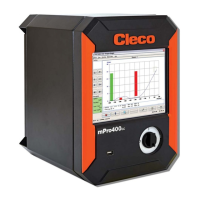17i_Kabel en.fm, 06.09.2011 P2077SB/EN 2011-09 51
Instructions on laying cables
12
For this, use the following shield clamps:
The shielding in the transducer line is connected to the connector housing. The front panel of the measuring
board is grounded via the STM housing and ensures good shielding connection.
➔ Maximum unshielded area of the motor line, between shield end and plug connection on tightening mod-
ule = 50 mm.
➔ On the Built-in nutrunner or hand tool, extensively connect the shield to the metal housing of the plug
connection.
Fig. 12-2
12.4 Laying "High-Flex Quality" cables in cable ducts
The laying of lines and protection hoses in cable ducts must be carried out with the greatest possible care.
Generally, the following points must be observed:
Cables Shield clamp
Order No. Phoenix
Name
Phoenix
Item number
DGD-IS cable, BTS series S961062 SK14 30 25 17 6
Hand tool cable S961062 SK14 30 25 17 6
➔ The cables should lie free of twists in the cable duct.Prior to assembly, lay the
cables on an even surface so that they can be inserted while stretched out.
➔ Lay the cables in the cable duct individually, lying loosely adjacent to each other
whenever possible. Lay a maximum of 2 cables per partition.
➔ Separate cables lying adjacent to each other using cut-off bridges whenever
possible.
➔ Don't bundle cables or fasten them with cable ties.
➔ Never lay cables with different diameters (> 3 mm) together in the same parti-
tion.
➔ Cables must be able to follow the radius of curvature without being forced
around it.
Vertical installation:
➔ Leave about 20% clearance within the partition height. The lines hang out
downward due to the cable weight, including the chain. This lengthening due to
sagging must be monitored at regular intervals and adjusted if necessary.
a00253_1.wmf
System cable

